Bus Service Level and Horizontal Equity Analysis in the Context of the Modifiable Areal Unit Problem
Abstract
:1. Introduction
2. Literature Review
3. Materials and Methods
3.1. Case Study
3.2. Data Sources
3.2.1. Geographic Zones and Population
- Neighbourhoods—The division into neighbourhoods in Palma city was provided by the Population Service of Palma City Council. A total of 88 areas of heterogeneous dimensions were recorded.
- Census sections—The National Institute of Statistics is responsible for carrying out the population census in Spain, which it does every 10 years. A total of 245 census sections were recorded.
- Cadastral blocks—From Palma City Council, through its Department of Population. The municipality of Palma comprises a total of 3012 cadastral blocks.
- 400 × 400 m mesh—A mesh of homogeneous square polygonal units of dimensions 400 × 400 m was created. The municipality comprises a total of 1381 units. Its population was obtained from census sections.
3.2.2. Bus Stops, Bus Lines, and Frequencies
3.3. Methodology
3.3.1. Calculation of the Bus Service Level and the Horizontal Equity Using the Current Bus Frequencies
- GIS database creation—Importation of geographical transport files (GTFC), bus stops, and routes (Figure 3a).
- Calculation of the Bus Service Level by Bus Stop—The level of service provided by each bus stop was calculated based on the number of buses that pass through it over the course of 12 h, according to the following expression:bs = bus stop; r = bus route; s = total number of routes; Freqr = Frequency of route r
- Calculation of the Bus Service Level (BSL) for each geographic unit—Using the DelBosc method [26], a buffer of 400 m was generated for each bus stop (Figure 3b) and the number of buses passing through this stop was counted. The buffer layer was then overlapped on each of the zonings carried out, obtaining a level of service for each geographical unit, according to the following expression (Figure 3c):x = geographic unit; bs = bus stop; m = number of bus stops
- Analysis of population concentration and bus service—An analysis of the spatial autocorrelation of the service level and population was carried out by calculating the Moran’s Global and Local indices [55,56,57]. The Moran’s Global index provides information on the spatial autocorrelation of the variable and its degree of concentration:N = number of indexed spatial units by i, j; X = value of the variable; = mean of X; Wij = weighted matrix element, where a value of −1 indicates maximum dispersion, a value of 0 indicates a random distribution, while a value equal to 1 indicates a concentrated distribution. The Local Moran’s index is used to verify the concentration of the variable in space (Figure 3f,f′).
- Mapping of territorial imbalances (Figure 3g)—A cartographic analysis was performed for each type of zoning, in order to represent the relationship between the population and level of service. For this purpose, the mapping of the level of service normalized by resident population was presented and deficit zones were identified. The process is carried out by classifying the population and the level of service in three categories (33 and 66 percentile), and represented by a map showing all the categories.
- Lorenz Curves generation (Figure 3h)—A Lorenz curve shows a cumulative distribution of the level of service and population for geographic units, as well as the straight line that would represent perfect equality in distribution [26,27]. A Lorenz curve was constructed for each of the zonings, based on the information corresponding to the population of each geographic unit and its level of service, in which the level of horizontal equity can be observed.
- Gini coefficient calculation—The Gini coefficient [26,58,59] was developed in the field of economics, in order to measure the degree of inequality of an economic variable (income) in relation to the population. The index is based on an analysis of the deviation from the Lorenz curve. The calculation of the Gini coefficient was carried out using accumulated population and service level data for each of the zonings used, according to the following expression (Figure 3i):i = row; n = number total of districts; Y = accumulated service level; X = accumulated population
3.3.2. Sensibility Analysis of Bus Service Level and Horizontal Equity by Simulation of the Change of Bus Frequencies (±5 min)
3.3.3. Optimization of Bus Fleet Frequencies
- Maximising the Global Service Level;
- Minimisation of the Gini coefficient; and
- Minimisation of population not covered by the Bus Service.
4. Results and Discussion
4.1. Service Level and Equity for Each Zoning with the Current Bus Frequencies
4.2. The Role of Bus Lines in Service Level and Horizontal Equity
4.3. Bus Frequencies Optimization to Improve Service Level and Horizontal Equity
5. Conclusions
- Small unit zoning is much more accurate for service-level analysis. Small units are also more sensitive to detecting imbalances between bus service supply and resident population levels.
- The range of variability of global indicators of concentration (Moran’s Global) did not undergo very significant changes, concerning the use of various zonings; in other words, service level concentrations were detected in all cases. However, the identification of the high bus service level areas (Moran’s Local) was more precise when using small unit zoning. The use of large units can hide significant areas of concentration.
- Orthogonal zoning (mesh) proved to be particularly sensitive for concentration detection, regardless of unit size. It has a tendency to soften the values of BSL improvement and equity, compared to the other zonings. At the same time, it provides a broader view of the municipality.
- The horizontal equity analysis showed that the Gini coefficient increases as the size of the geographical units decreases. This implies that the smaller the geographical unit used, the greater the sensitivity in detecting imbalances. In other words, many imbalances could go undetected if large geographical units are used.
- The sensitivity analysis of bus service level and equity derived from the variation of route frequencies showed the strong dependence of service level on a series of long-distance routes that radially cross the city. This bus transportation system demonstrates rigidity.
- There were significant variations in the roles of bus lines, depending on the type of zoning used. In general, there was a coincidence in the zoning systems, in terms of identifying the lines that improve the level of service. However, there were significant divergences for the maintenance of equity; these issues are unclear.
- In optimizing the level of service and horizontal equity by changing the frequencies of bus lines, it became clear that fundamental changes must be made to the city’s key lines. The variations to the original service level values are significant and can lead to improvements in many areas.
Author Contributions
Funding
Acknowledgments
Conflicts of Interest
References
- Levine, C. The concept of vulnerability in disaster research. J. Trauma. Stress 2004, 17, 395–402. [Google Scholar] [CrossRef]
- Fotheringham, A.S.; Wong, D.W.S. The modifiable areal unit problem in multivariate statistical analysis. Environ. Plan. A 1991, 23, 1025–1044. [Google Scholar] [CrossRef]
- Openshaw, S. Ecological fallacies and the analysis of areal census data (UK, Italy). Environ. Plan. A 1984, 16, 17–31. [Google Scholar] [CrossRef] [PubMed] [Green Version]
- Pereira, R.H.M.; Banister, D.; Schwanen, T.; Wessel, N. Distributional effects of transport policies on inequalities in access to opportunities in Rio de Janeiro. J. Transp. Land Use 2019, 12, 741–764. [Google Scholar] [CrossRef] [Green Version]
- Mitra, R.; Buliung, R.N. Built environment correlates of active school transportation: Neighborhood and the modifiable areal unit problem. J. Transp. Geogr. 2012, 20, 51–61. [Google Scholar] [CrossRef]
- Röthlisberger, V.; Zischg, A.P.; Keiler, M. Identifying spatial clusters of flood exposure to support decision making in risk management. Sci. Total Environ. 2017, 598, 593–603. [Google Scholar] [CrossRef] [Green Version]
- Wang, C.; Quddus, M.A.; Ryley, T.; Enoch, M.; Davison, L. Spatial models in transport: A review and assessment of methodological issues. In Proceedings of the 91st Annual Meeting of the Transportation Research Board, Washington, DC, USA, 22–26 January 2012; Volume 750. [Google Scholar] [CrossRef]
- Biehl, A.; Ermagun, A.; Stathopoulos, A. Community mobility MAUP-ing: A socio-spatial investigation of bikeshare demand in Chicago. J. Transp. Geogr. 2018, 66, 80–90. [Google Scholar] [CrossRef]
- Viegas, J.M.; Martínez, L.M.; Silva, E.A. Effects of the modifiable areal unit problem on the delineation of traffic analysis zones. Environ. Plan. B Plan. Des. 2009, 36, 625–643. [Google Scholar] [CrossRef] [Green Version]
- Litman, T. Evaluating Transport Equity. World Transp. Policy Pract. 2002, 8, 50–65. [Google Scholar]
- Ruiz, M.; Segui-Pons, J.M.; Mateu-LLadó, J. Improving Bus Service Levels and social equity through bus frequency modelling. J. Transp. Geogr. 2017, 58, 220–233. [Google Scholar] [CrossRef]
- Eisenberg-Guyot, J.; Moudon, A.V.; Hurvitz, P.M.; Mooney, S.J.; Whitlock, K.B.; Saelens, B.E. Beyond the bus stop: Where transit users walk. J. Transp. Heal. 2019, 14, 100604. [Google Scholar] [CrossRef] [PubMed]
- Corazza, M.V.; Favaretto, N. A methodology to evaluate accessibility to bus stops as a contribution to improve sustainability in urban mobility. Sustainability 2019, 11, 803. [Google Scholar] [CrossRef] [Green Version]
- Laasasenaho, K.; Lensu, A.; Lauhanen, R.; Rintala, J. GIS-data related route optimization, hierarchical clustering, location optimization, and kernel density methods are useful for promoting distributed bioenergy plant planning in rural areas. Sustain. Energy Technol. Assess. 2019, 32, 47–57. [Google Scholar] [CrossRef]
- Kallel, A.; Serbaji, M.M.; Zairi, M. Using GIS-Based Tools for the Optimization of Solid Waste Collection and Transport: Case Study of Sfax City, Tunisia. J. Eng. 2016. [Google Scholar] [CrossRef] [Green Version]
- Krichen, S.; Faiz, S.; Tlili, T.; Tej, K. Tabu-based GIS for solving the vehicle routing problem. Expert Syst. Appl. 2014, 41, 6483–6493. [Google Scholar] [CrossRef]
- Kucuksari, S.; Khaleghi, M.A.; Hamidi, M.; Zhang, Y.; Szidarovszky, F.; Bayraksan, G.; Son, J.Y. An Integrated GIS, optimization and simulation framework for optimal PV size and location in campus area environments. Appl. Energy 2014, 113, 1601–1613. [Google Scholar] [CrossRef]
- Li, X.; Chen, Y.; Liu, X.; Li, D.; He, J. Concepts, methodologies, and tools of an integrated geographical simulation and optimization system. Int. J. Geogr. Inf. Sci. 2011, 25, 633–655. [Google Scholar] [CrossRef] [Green Version]
- Santé-Riveira, I.; Crecente-Maseda, R.; Miranda-Barrós, D. GIS-based planning support system for rural land-use allocation. Comput. Electron. Agric. 2008, 63, 257–273. [Google Scholar] [CrossRef]
- Hadas, Y. Assessing public transport systems connectivity based on Google Transit data. J. Transp. Geogr. 2013, 33, 105–116. [Google Scholar] [CrossRef]
- Porter, J.D.; Kim, D.S.; Ghanbartehrani, S. Proof of Concept: GTFS Data as a Basis for Optimization of Oregon’s Regional and Statewide Transit Networks; No. FHWA-OR-RD-14-12; Oregon Department of Transportation Research Section: Salem, OR, USA, 2014.
- Sun, F.; Samal, C.; White, J.; Dubey, A. Unsupervised Mechanisms for Optimizing On-Time Performance of Fixed Schedule Transit Vehicles. In Proceedings of the 2017 IEEE International Conference on Smart Computing (SMARTCOMP), Hong Kong, China, 29–31 May 2017. [Google Scholar] [CrossRef]
- Owens, S. From ‘predict and provide’ to ‘predict and prevent’? Pricing and planning in transport policy. Transp. Policy 1995, 2, 43–49. [Google Scholar] [CrossRef]
- Lucas, K. Transport and social exclusion: Where are we now? Transp. Policy 2012, 20, 105–113. [Google Scholar] [CrossRef]
- Boisjoly, A.; El-Geneidy, G. Public transport equity outcomes through the lens of urban form. In Urban Form and Accessibility; Elsevier: Amsterdam, The Netherlands, 2021; pp. 223–241. [Google Scholar]
- Delbosc, A.; Currie, G. Using Lorenz curves to assess public transport equity. J. Transp. Geogr. 2011, 19, 1252–1259. [Google Scholar] [CrossRef]
- Delbosc, A.; Currie, G. The spatial context of transport disadvantage, social exclusion and well-being. J. Transp. Geogr. 2011, 19, 1130–1137. [Google Scholar] [CrossRef]
- Ferguson, E.M.; Duthie, J.; Unnikrishnan, A.; Waller, S.T. Incorporating equity into the transit frequency-setting problem. Transp. Res. Part A Policy Pract. 2012, 46, 190–199. [Google Scholar] [CrossRef]
- Pereira, R.H.M.; Schwanen, T.; Banister, D. Distributive justice and equity in transportation. Transp. Rev. 2017, 37, 170–191. [Google Scholar] [CrossRef]
- Lucas, K.; van Wee, B.; Maat, K. A method to evaluate equitable accessibility: Combining ethical theories and accessibility-based approaches. Transportation 2016, 43, 473–490. [Google Scholar] [CrossRef] [Green Version]
- El-Geneidy, A.; Levinson, D.; Diab, E.; Boisjoly, G.; Verbich, D.; Loong, C. The cost of equity: Assessing transit accessibility and social disparity using total travel cost. Transp. Res. Part A Policy Pract. 2016, 91, 302–316. [Google Scholar] [CrossRef] [Green Version]
- Liu, C.; Duan, D. Spatial inequality of bus transit dependence on urban streets and its relationships with socioeconomic intensities: A tale of two megacities in China. J. Transp. Geogr. 2020, 86, 102768. [Google Scholar] [CrossRef]
- Aman, J.J.C.; Smith-Colin, J. Transit Deserts: Equity analysis of public transit accessibility. J. Transp. Geogr. 2020, 89, 102869. [Google Scholar] [CrossRef]
- Mendiola, L.; González, P.; Cebollada, À. The relationship between urban development and the environmental impact mobility: A local case study. Land Use Policy 2015, 43, 119–128. [Google Scholar] [CrossRef]
- Barboza, M.H.C.; Carneiro, M.S.; Falavigna, C.; Orrico, R. Balancing time: Using a new accessibility measure in Rio de Janeiro. J. Transp. Geogr. 2021, 90, 02924. [Google Scholar] [CrossRef]
- Guo, Y.; Chen, Z.; Stuart, A.; Li, X.; Zhang, Y. A systematic overview of transportation equity in terms of accessibility, traffic emissions, and safety outcomes: From conventional to emerging technologies. Transp. Res. Interdiscip. Perspect. 2020, 4, 100091. [Google Scholar] [CrossRef]
- Mooney, J.S.; Hosford, K.; Howe, B.; Yan, A.; Winters, M.; Bassok, A.; Hirsch, A.J. Freedom from the station: Spatial equity in access to dockless bike share. J. Transp. Geogr. 2019, 74, 91–96. [Google Scholar] [CrossRef] [PubMed]
- Braun, L.M.; Rodriguez, D.A.; Gordon-Larsen, P. Social (in)equity in access to cycling infrastructure: Cross-sectional associations between bike lanes and area-level sociodemographic characteristics in 22 large U.S. cities. J. Transp. Geogr. 2019, 80, 102544. [Google Scholar] [CrossRef]
- Sharma, I.; Mishra, S.; Golias, M.M.; Welch, T.F.; Cherry, C.R. Equity of transit connectivity in Tennessee cities. J. Transp. Geogr. 2020, 86, 102750. [Google Scholar] [CrossRef]
- Manrique, J.; Cordera, R.; Moreno, E.G.; Oreña, B.A. Equity analysis in access to Public Transport through a Land Use Transport Interaction Model. Application to Bucaramanga Metropolitan Area-Colombia. Res. Transp. Bus. Manag. 2020, 100561. [Google Scholar] [CrossRef]
- Romero, N.; Nozick, L.K.; Xu, N. Hazmat facility location and routing analysis with explicit consideration of equity using the Gini coefficient. Transp. Res. Part E Logist. Transp. Rev. 2016, 89, 165–181. [Google Scholar] [CrossRef]
- Park, C.; Chang, J.S. Spatial equity of excess commuting by transit in Seoul. Transp. Plan. Technol. 2020, 43, 101–112. [Google Scholar] [CrossRef]
- Banister, D. The sustainable mobility paradigm. Transp. Policy 2008, 15, 73–80. [Google Scholar] [CrossRef]
- Horner, M.W.; Murray, A.T. Excess commuting and the modifiable areal unit problem. Urban Stud. 2002, 39, 131–139. [Google Scholar] [CrossRef]
- Kwan, M.P.; Weber, J. Scale and accessibility: Implications for the analysis of land use-travel interaction. Appl. Geogr. 2008, 28, 110–123. [Google Scholar] [CrossRef]
- Xu, P.; Huang, H.; Dong, N.; Abdel-Aty, M. Sensitivity analysis in the context of regional safety modeling: Identifying and assessing the modifiable areal unit problem. Accid. Anal. Prev. 2014, 70, 110–120. [Google Scholar] [CrossRef] [PubMed]
- Pani, A.; Sahu, P.K.; Chandra, A.; Sarkar, A.K. Assessing the extent of modifiable areal unit problem in modelling freight (trip) generation: Relationship between zone design and model estimation results. J. Transp. Geogr. 2019, 80, 102524. [Google Scholar] [CrossRef]
- Neutens, T. Accessibility, equity and health care: Review and research directions for transport geographers. J. Transp. Geogr. 2015, 43, 14–27. [Google Scholar] [CrossRef]
- Instituto Nacional de Estadística (INE). Available online: https://www.ine.es/ (accessed on 15 December 2020).
- Empresa Municipal de Transports Urbans de Palma. Available online: http://www.emtpalma.cat/en/home/ (accessed on 15 December 2020).
- El-Geneidy, A.; Grimsrud, M.; Wasfi, R.; Tétreault, P.; Surprenant-Legault, J. New evidence on walking distances to transit stops: Identifying redundancies and gaps using variable service areas. Transportation 2014, 41, 193–210. [Google Scholar] [CrossRef]
- Anselin, L. An Introduction to Spatial Autocorrelation Analysis with GeoDa. GeoDa Documentation. 2002. Available online: http://www.csiss.org/clearinghouse/GeoDa/ (accessed on 1 December 2020).
- Goodchild, F.M.; Anselin, L.; Deichmann, U. A framework for the areal interpolation of socioeconomic data. Environ. Plan. A 1993, 25, 383–397. [Google Scholar] [CrossRef]
- Hawley, K.; Moellering, H. A comparative analysis of areal interpolation methods. Cartogr. Geogr. Inf. Sci. 2005, 32, 411–423. [Google Scholar] [CrossRef]
- Talen, E.; Anselin, L. Assessing spatial equity: An evaluation of measures of accessibility to public playgrounds. Environ. Plan. A 1998, 30, 595–613. [Google Scholar] [CrossRef] [Green Version]
- Anselin, L. Exploring Spatial Data with GeoDA: A Work Book; Center for Spatially Integrated Social Science, University of Illinois: Chicago, IL, USA, 2005. [Google Scholar]
- Rey, S.J.; Anselin, L. PySAL: A Python library of spatial analytical methods. In Handbook of Applied Spatial Analysis; Springer: Berlin/Heidelberg, Germany, 2010; pp. 175–193. [Google Scholar]
- Ricciardi, A.M.; Xia, J.C.; Currie, G. Exploring public transport equity between separate disadvantaged cohorts: A case study in Perth, Australia. J. Transp. Geogr. 2015, 43, 111–122. [Google Scholar] [CrossRef]
- Sitthiyot, T.; Holasut, K. A simple method for measuring inequality. Palgrave Commun. 2020, 6, 1–9. [Google Scholar] [CrossRef]
- Palisade Corporation. @Risk: Risk Analysis Software Using Monte Carlo Simulation; Palisade Corporation: Ithaca, NY, USA, 2012. [Google Scholar]
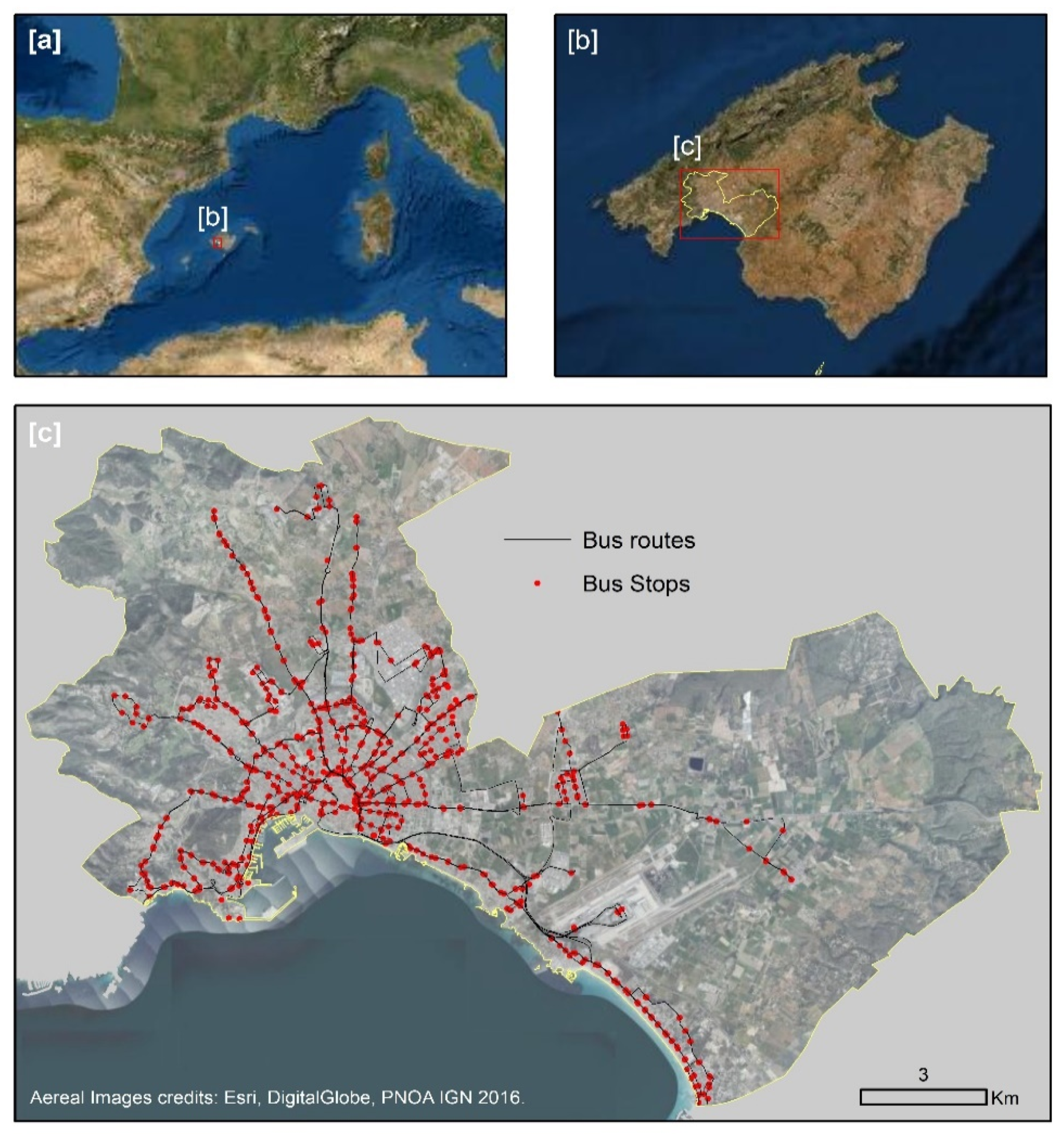

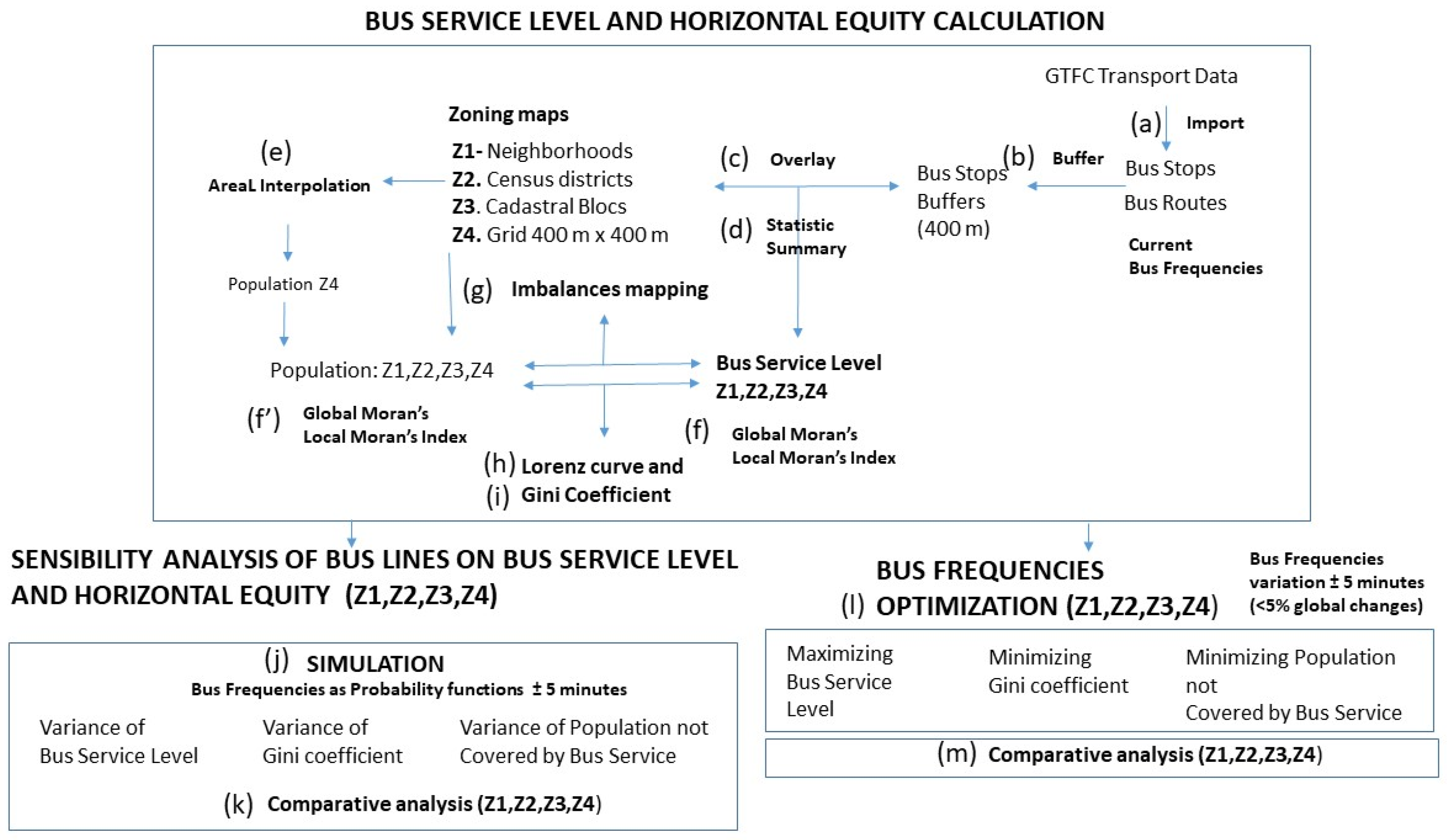

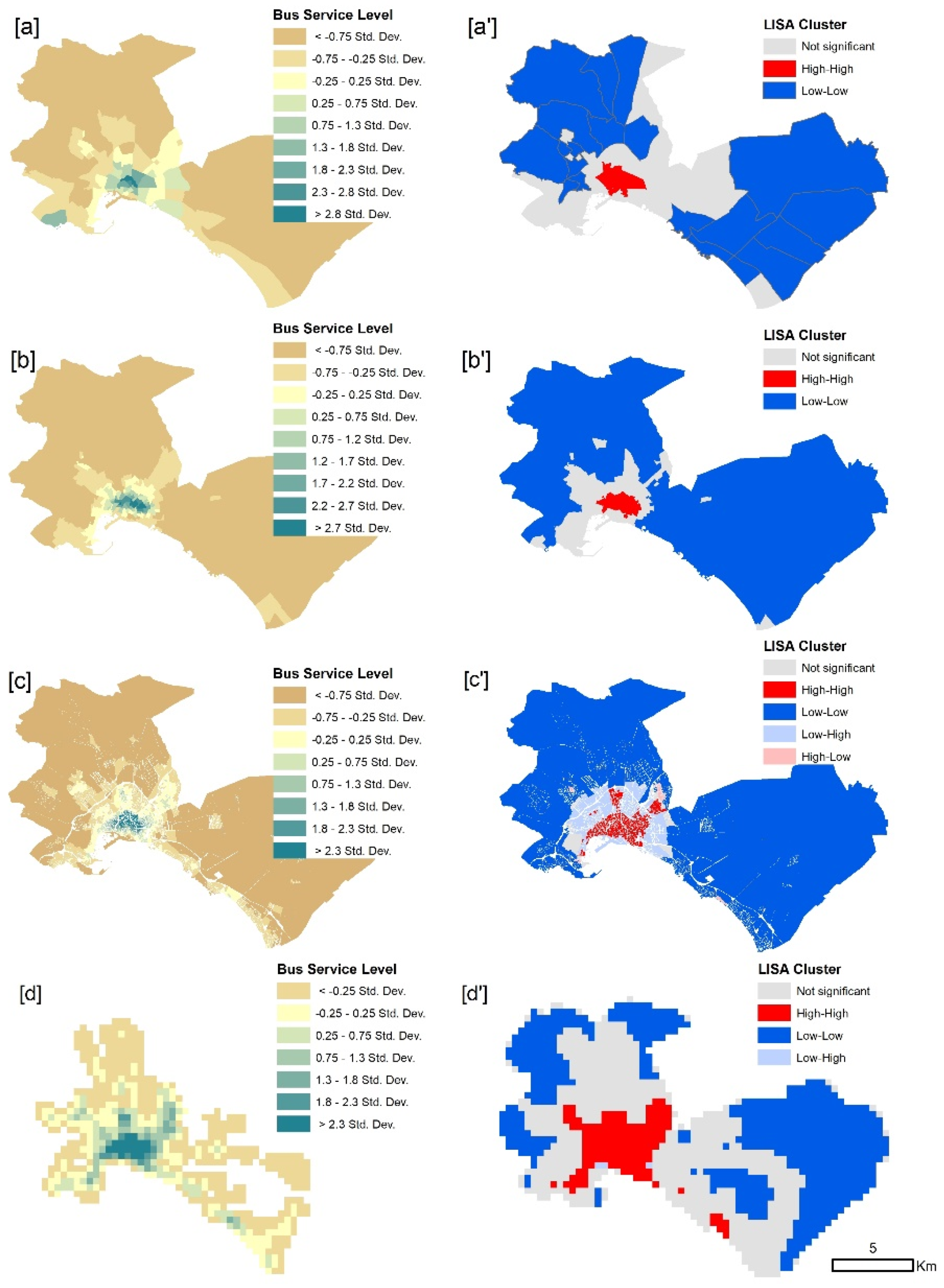
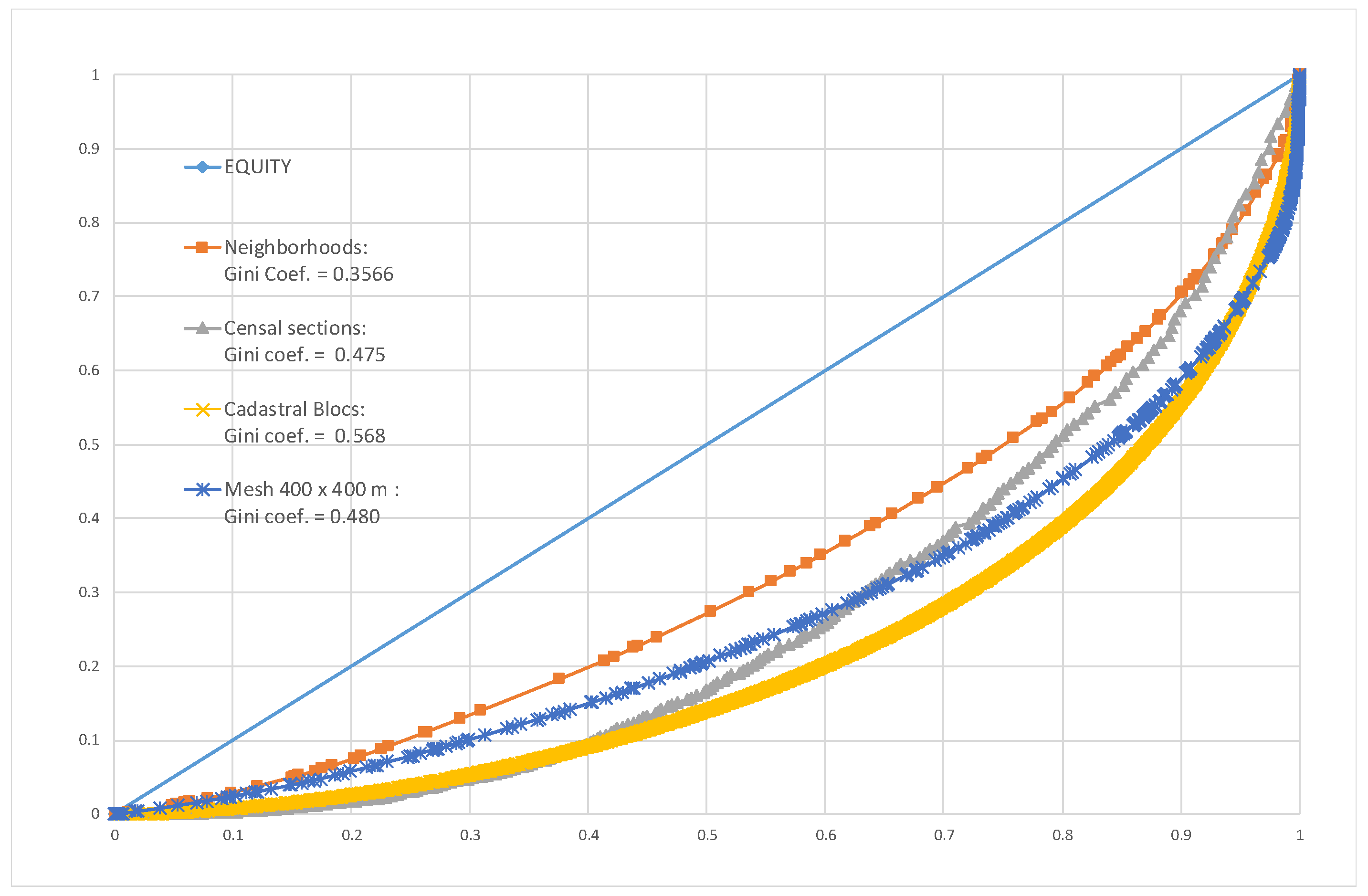
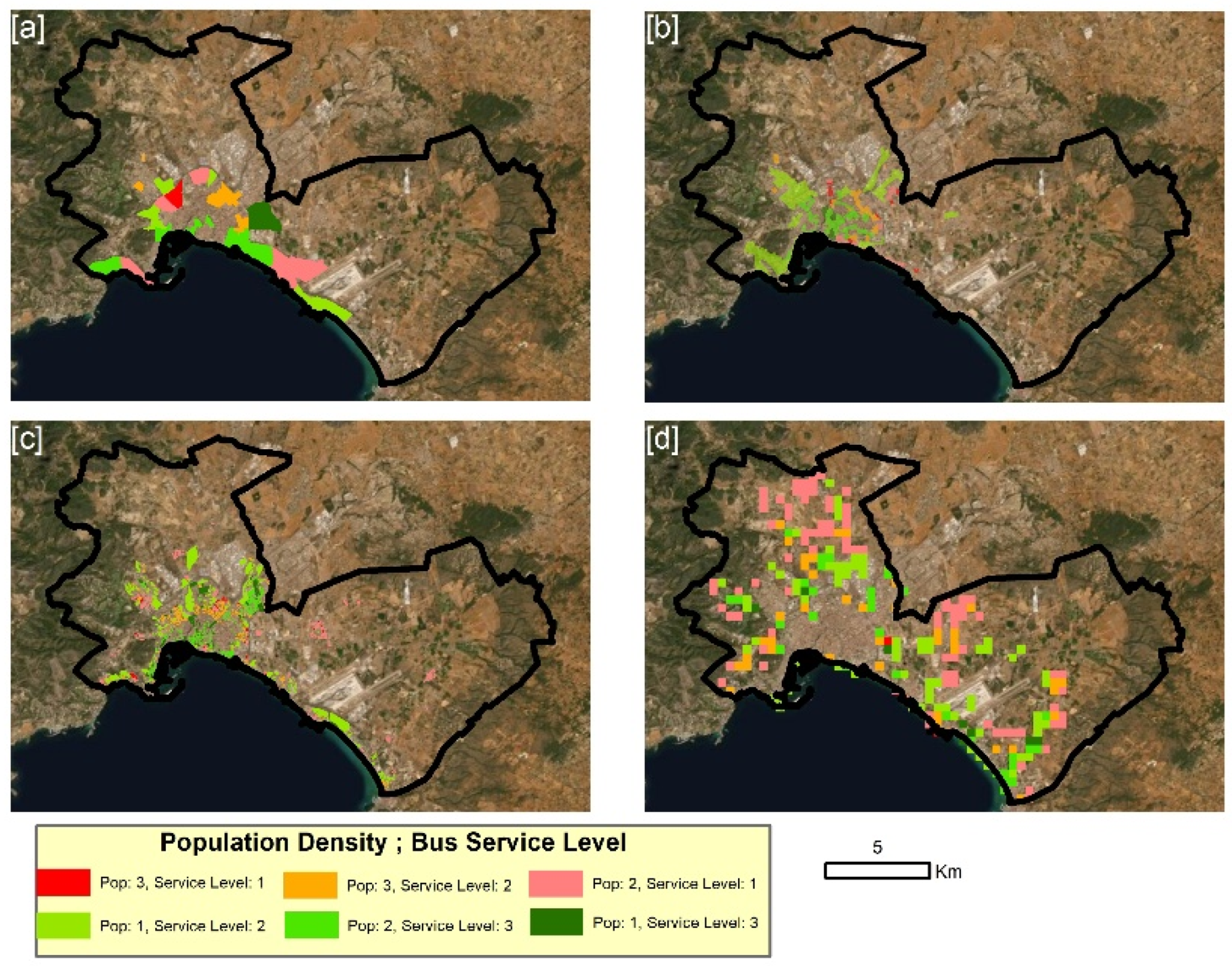


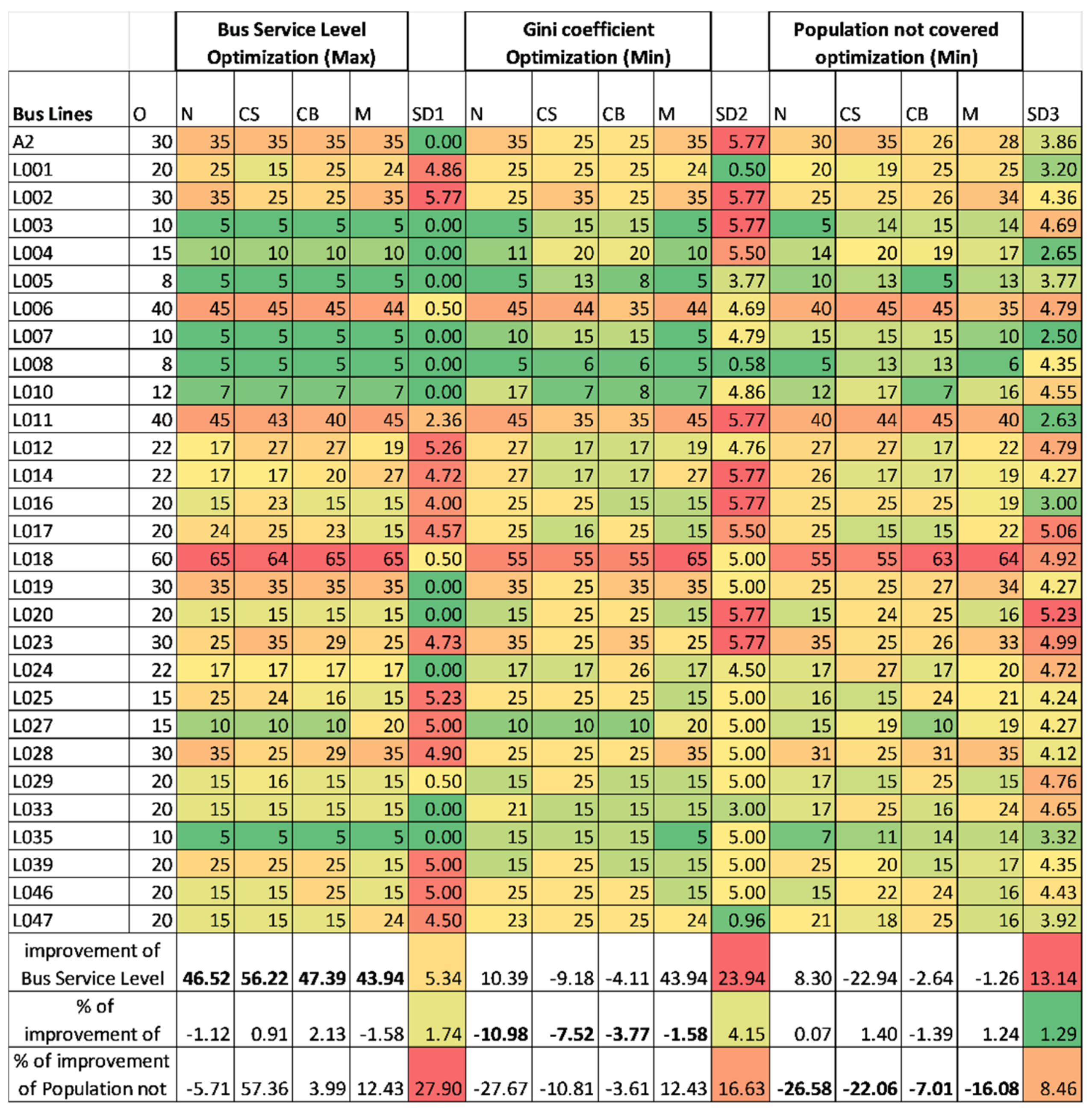
| Indicators | Neighbourhoods | Census Sections | Cadastral Blocks | 400 × 400 m Mesh |
|---|---|---|---|---|
| Nº Units | 88 | 245 | 3012 | 1381 |
| Minimum surface (HA) | 4.35 | 1.53 | 0.01 | 16.00 |
| Mean surface (HA) | 222.08 | 79.66 | 6.10 | 16.00 |
| Maximum surface (HA) | 3771.88 | 3918.45 | 185.14 | 16.00 |
| Standard deviation | 509.92 | 318.40 | 55.53 | 0 |
| Minimum population | 0 | 0 | 0 | 0 |
| Mean population | 4786.29 | 1634.16 | 153.22 | 335.35 |
| Maximum population | 27,872 | 4430 | 2285 | 8461.72 |
| Standard deviation population | 4759.25 | 622.60 | 186.48 | 1050.72 |
| Minimum population density | 0 | 0 | 0 | 0 |
| Mean population density (inhab/ha) | 130.03 | 249.90 | 329.97 | 20.95 |
| Maximum population density (inhab/ha) | 558.24 | 1171.19 | 3251.17 | 528.85 |
| Standard deviation Population density | 118.78 | 241.64 | 391.26 | 65.67 |
| Route | Frequency (min) | Route | Frequency (min) |
|---|---|---|---|
| L001 | 20 | L019 | 30 |
| L002 | 30 | L020 | 20 |
| L003 | 10 | L023 | 30 |
| L004 | 15 | L024 | 22 |
| L005 | 8 | L025 | 20 |
| L006 | 40 | L027 | 15 |
| L007 | 10 | L028 | 30 |
| L008 | 8 | L029 | 20 |
| L010 | 12 | L031 | 20 |
| L011 | 40 | L033 | 20 |
| L012 | 22 | L035 | 10 |
| L014 | 22 | L039 | 20 |
| L016 | 20 | L046 | 20 |
| L017/A1 | 20 | L047 | 20 |
| L018 | 60 | A2 | 30 |
| Neighbourhoods | Census Sections | Cadastral Blocks | 400 × 400 m Mesh | |
|---|---|---|---|---|
| Population | 0.146 | 0.01 | 0 | 0.749 |
| Density Population | 0.471 | 0.328 | 0.239 | 0.749 |
| Bus Service Level | 0.669 | 0.820 | 0.829 | 0.809 |
Publisher’s Note: MDPI stays neutral with regard to jurisdictional claims in published maps and institutional affiliations. |
© 2021 by the authors. Licensee MDPI, Basel, Switzerland. This article is an open access article distributed under the terms and conditions of the Creative Commons Attribution (CC BY) license (http://creativecommons.org/licenses/by/4.0/).
Share and Cite
Ruiz-Pérez, M.; Seguí-Pons, J.M. Bus Service Level and Horizontal Equity Analysis in the Context of the Modifiable Areal Unit Problem. ISPRS Int. J. Geo-Inf. 2021, 10, 111. https://0-doi-org.brum.beds.ac.uk/10.3390/ijgi10030111
Ruiz-Pérez M, Seguí-Pons JM. Bus Service Level and Horizontal Equity Analysis in the Context of the Modifiable Areal Unit Problem. ISPRS International Journal of Geo-Information. 2021; 10(3):111. https://0-doi-org.brum.beds.ac.uk/10.3390/ijgi10030111
Chicago/Turabian StyleRuiz-Pérez, Maurici, and Joana Maria Seguí-Pons. 2021. "Bus Service Level and Horizontal Equity Analysis in the Context of the Modifiable Areal Unit Problem" ISPRS International Journal of Geo-Information 10, no. 3: 111. https://0-doi-org.brum.beds.ac.uk/10.3390/ijgi10030111







